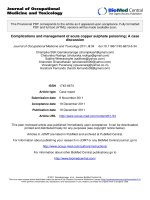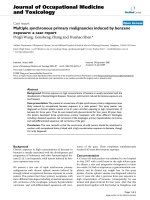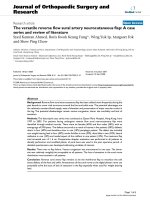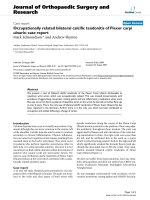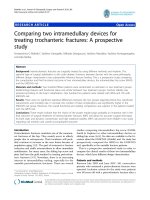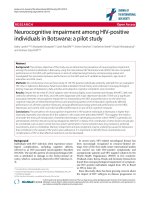Báo cáo hóa học: " Melioidosis presenting with mediastinal lymphadenopathy masquerading as malignancy: a case report" pot
Bạn đang xem bản rút gọn của tài liệu. Xem và tải ngay bản đầy đủ của tài liệu tại đây (210.11 KB, 13 trang )
This Provisional PDF corresponds to the article as it appeared upon acceptance. Fully formatted
PDF and full text (HTML) versions will be made available soon.
Melioidosis presenting with mediastinal lymphadenopathy masquerading as
malignancy: a case report
Journal of Medical Case Reports 2012, 6:28 doi:10.1186/1752-1947-6-28
Kavitha Saravu ()
Chiranjay Mukhopadhyay ()
Vandana KALWAJE Eshwara ()
Barkur ANANTHAKRISHNA Shastry ()
Kundapura Ramamoorthi ()
Sushma Krishna ()
Vishwanath Satyanarayanan ()
ISSN 1752-1947
Article type Case report
Submission date 7 September 2011
Acceptance date 23 January 2012
Publication date 23 January 2012
Article URL />This peer-reviewed article was published immediately upon acceptance. It can be downloaded,
printed and distributed freely for any purposes (see copyright notice below).
Articles in Journal of Medical Case Reports are listed in PubMed and archived at PubMed Central.
For information about publishing your research in Journal of Medical Case Reports or any BioMed
Central journal, go to
/>For information about other BioMed Central publications go to
/>Journal of Medical Case
Reports
© 2012 Saravu et al. ; licensee BioMed Central Ltd.
This is an open access article distributed under the terms of the Creative Commons Attribution License ( />which permits unrestricted use, distribution, and reproduction in any medium, provided the original work is properly cited.
Melioidosis presenting with mediastinal lymphadenopathy
masquerading as malignancy: a case report
Kavitha Saravu
1
*, Chiranjay Mukhopadhyay
2
, Vandana Kalwaje Eshwara
2
,
Barkur Ananthakrishna Shastry
1
, Kundapura Ramamoorthy
1
, Sushma
Krishna
3
, Vishwanath Sathyanarayanan
1
1
Department of Internal Medicine, Kasturba Medical College, Manipal
University, Karnataka, India.
2
Department of Microbiology, Kasturba Medical
College, Manipal University, Karnataka, India.
3
Department of Microbiology,
Amrita Institute of Medical Sciences, Cochin. Kerala, India.
* Corresponding author
KS:
CM:
VKE:
ABS:
KR:
SK:
VS -
Key Words:
melioidosis, mediastinal mass, lymphadenopathy, malignancy, tuberculosis
Abstract
Introduction: Melioidosis, endemic in Thailand and in the Northern Territory of
Australia is an emerging infectious disease in India which can present with varied
forms. A case of melioidosis, presenting as a rare anterior mediastinal mass which
can masquerade as a malignancy or as tuberculosis, is described. Our patient
developed new submandibular lymph nodes and the mediastinal node initially
increased in size on treatment. To the best of our knowledge, this phenomenon has
not been documented in the literature. It is important to document the same
which is highlighted in this case report.
Case Presentation: A 43-year-old Asian man with diabetes presented with fever,
loss of appetite, weight loss for one month and painful swelling below his left
mandible for five days. An examination revealed an enlarged left submandibular
lymph node and bilateral axillary lymph nodes. A chest X-ray showed mediastinal
widening. Computed tomography of his thorax showed a lobulated heterogeneously
enhancing anterior mediastinal mass encasing the superior vena cava suggestive of
malignancy. An excision biopsy of the lymph node showed granulomas suggestive
of tuberculosis but bone marrow culture and lymph node aspirate culture grew
Burkholderia pseudomallei. He was treated with parenteral ceftazidime and
amoxicillin-clavulanic acid. During the course of treatment, he developed an
enlargement of the submandibular lymph node on the opposite side. It gradually
subsided with the continuation of therapy orally with a combination of
cotrimoxazole and doxycycline for six months. A repeat computed tomography
chest scan showed resolution of the mediastinal mass.
Conclusion: Melioidosis can present as a mediastinal mass that mimics tuberculosis
or malignancy. During the treatment of melioidosis, the appearance of new lymph
nodes or an increase in the size of the existing lymph nodes does not mean
treatment failure. Inexperienced clinicians may consider this as treatment failure
and may switch treatment. To the best of our knowledge, this is the first report
documenting this phenomenon in melioidosis cases.
Introduction
Melioidosis is called a mimicker of maladies. In its acute form it can mimic any
community acquired bacterial sepsis, pneumonia or abscess, especially that
produced by staphylococcus. In its chronic form, it can mimic tuberculosis or
malignancy [1]. Melioidosis can present with subcutaneous abscesses and visceral
abscesses in the liver, spleen, prostate, parotid, and lymph nodal mass [2, 3].
Melioidosis is endemic in Northern Australia, Thailand, Singapore, Malaysia,
Myanmar and Vietnam [3]. In India, it is sporadic with an increasing trend in the
southern states [4]. Burkholderia pseudomallei, the causative organism, is a gram
negative, motile bacillus isolated from soil and surface water. The disease is
acquired by inoculation through abraded skin, inhalation or ingestion [5]. The
majority of cases present during the rainy season [6]. The incubation period ranges
from 24 hours to many years [3]. In an Australian study, chronic renal disease,
chronic lung disease, and age >45 years were independent risk factors for
melioidosis [7]. It produces necrotizing inflammation, abscess or granuloma with
multinucleated giant cells [8]. Clinical disease may present acutely with a fever of
less than two months duration or chronically with more than two months of fever
with or without other symptoms such as cough, discharging sinus, and subcutaneous
swellings. Localized disease presents as skin ulcers and subcutaneous abscesses or
pneumonia. Disseminated disease can present with pneumonia, abscesses in the
liver, spleen, kidney, prostate, skin and subcutaneous tissue, septic arthritis and
osteomyelitis with or without septicemia. Lymph node swelling with necrosis can
occur as part of either disseminated melioidosis or its local forms [3, 4]. However,
mediastinal lymphadenopathy as a presenting feature of melioidosis is rare. We
present a case of a patient with melioidosis which involved the mediastinal lymph
node and mimicked malignancy and tuberculosis.
Case presentation
A 43-year-old Asian man with diabetes, a clerk in an office, presented with a fever
of one month and painful swelling below the left submandibular region of five days
duration with a history of weight loss and poor appetite. An examination revealed a
febrile patient with multiple lymph node swellings. His left submandibular lymph
node was 2X1cm and tender. His bilateral axillary nodes were palpable, the largest
being 0.5X0.5cm. Vital signs and systemic examination were normal. Investigations
revealed neutrophilic leukocytosis with high erythrocyte sedimentation rate. and
uncontrolled diabetes mellitus. His chest X-ray showed widening of the right
paratracheal region probably due to lymph node enlargement (Figure1). He was
empirically started on intravenous amoxicillin-clavulanic acid and subcutaneous
insulin. A computed tomography (CT) scan of his thorax showed an anterior
mediastinal mass measuring 4.2X3.7X3cm in the right paratracheal region
suggestive of a malignant mass with a few upper lobe densities (Figure 2). An
excision biopsy of the submandibular swelling showed a non-caseating granuloma
composed of lymphocytes and plasma cells suggestive of tuberculosis. A tuberculin
skin test was negative. His bone marrow did not show acid fast bacilli or
granuloma. Anti-tuberculosis treatment was not administered. Blood culture and
bone marrow culture grew B. pseudomallei sensitive to amoxicillin-clavulanic acid,
ceftazidime, piperacillin, cefaperazone-sulbactum, co-trimoxazole, doxycycline,
tetracycline, meropenem and imipenem. He was treated for two weeks with
ceftazidime (2gm every six hours intravenously). During his hospital stay, he
developed new right submandibular lymhadenopathy. However, the same
treatment was continued. He became afebrile in eight days. He was discharged
with oral co-trimoxazole (40/8mg/kg) and doxycycline (100mg) every 12 hours. At
one month, a CT scan of his thorax revealed an increase in the right paratracheal
lesion with the resolution of upper lobe densities. Treatment was continued with
oral co-trimoxazole and doxycycline for six months and a repeated computed
tomography (CT) scan of his chest was normal.
Discussion
Melioidosis cases can present as a mediastinal mass mimicking malignancy or
tuberculosis. This is because of enlarged mediastinal lymph nodes with necrosis.
They must be evaluated by fine needle aspiration and cytology (FNAC) or biopsy.
Mediastinal lymphadenopathy has been reported in 3% of patients in a 20-year
Darwin prospective study [9]. Few other cases are reported in the literature with
mediastinal lymphadenopathy [2, 10]. This could be secondary to inhalation or due
to hematogenous spread following inoculation.
Chronic melioidosis can be confused with tuberculosis clinically as well as
histopathologically. Histopathology of these lesions can show granulomas. In our
case it was a non-caseating granuloma and the tuberculin skin test was negative.
The growth of B. pseudomallei settled the diagnosis in our patient and hence the
ability to identify the growth is of paramount importance. This case report
highlights the fact that encasement of the superior vena cava can occur
occasionally in non-malignant conditions.
The initial intensive phase of parenteral therapy for melioidosis is with ceftazidime
50mg/kg (up to 2g) every six hours or meropenem 25mg/kg (up to1g) every eight
hours, or imipenem 25mg/kg (up to 1g) every six hours with or without
sulfamethoxazole/trimethoprim 40/8mg/kg (up to 1600/320mg) every 12 hours for
10 to 14 days. Deep seated abscesses extensive pulmonary disease, osteomyelitis,
septic arthritis and neurological melioidosis require four to eight weeks of the
intensive phase. Subsequent oral eradication therapy is required to prevent
recrudescence or relapse. Sulfamethoxazole/trimethoprim 40/8mg/kg (up to
1600/320mg) every 12 hours for three to six months is recommended [3].
Another interesting feature of our case is the appearance of new submandibular
swelling while our patient was receiving appropriate therapy and an increase in the
size of the mediastinal lymph node. There was an increase in the size of
mediastinal lymphadenopathy as evidenced by a repeated CT scan which was done
at the one-month follow up. In a review by White, the author opined that the
enlargement of an abscess or appearance of new abscesses, especially in skeletal
muscle, or seeding to a joint, is not uncommon in the first week of treatment, and
is not necessarily a sign of treatment failure [5]. However, we did not find any
documentation of this phenomenon in the literature. Two mechanisms can be put
forth for this. The first is the initial progression of the infection which may
sometimes be seen despite the use of appropriate antibiotics and its eventual
resolution. Another concomitant or additional mechanism is that lymph node
enlargement may represent an immune mediated response to infection, something
similar to the paradoxical reaction seen in tuberculosis.
Conclusion
The appearance of new lymph nodes or an increase in the size of the existing
lymph nodes does not mean treatment failure and the appropriate treatment has
to be continued. Melioidosis can mimic tuberculosis and malignancy and always has
to be considered in the differential diagnosis of lymphadenopathy with or without
fever in endemic areas or in travellers returning from endemic areas.
Consent
Written informed consent was obtained from the patient for publication of this
case report and any accompanying images. A copy of the written consent is
available for review by the Editor-in-Chief of this journal
Competing interests
The authors declare that they have no competing interests.
Authors' contributions
KS, BAS and VS managed the patient. KS, CM, VKE and RK prepared and edited the
manuscript. SK and RK helped in data collection. All authors read and approved
the final manuscript
Acknowledgements
We are grateful to the patient who consented to publish this data. We acknowledge
Dr. Bart Currie, Head of Infectious Disease Division, Menzies School of Health
Research, Charles Darwin University, Darwin, Northern Territory Australia for his
review of the manuscript and helpful suggestions.
References
[1] Vidyalakshmi K, Chakrapani M, Shrikala B, Damodar S, Lipika S, Vishal S:
Tuberculosis mimicked by Melioidosis. Int J Tuberc Lung Dis 2008, 12:1209-1215.
[2] Saravu K, Vishwanath S, Kumar RS, Barkur AS, Varghese GK, Mukhyopadhyay
C, Bairy I: Melioidosis-a case series from south India. Trans R Soc Trop Med Hyg
2008, 102:S18-S20.
[3] Cheng AC, Currie BJ. Melioidosis: epidemiology, pathophysiology, and
management. Clin Microbiol Rev 2005, 18:383-416.
[4] Saravu K, Mukhopadhyay C, S Vishwanath, Valsalan R, Vandana KE, Shastry
BA, Bairy I, Sugandhi Rao: Melioidosis in Southern India- epidemiological and
clinical profile. Southeast Asian J Trop Med Public Health 2010, 41:401-410.
[5] White NJ: Melioidosis. Lancet 2003, 361:1715-1722.
[6] Currie BJ, Fisher DA, Howard DM, Burrow JN, Lo D, Selva-Nayagam S, Anstey
NM, Huffam SE, Snelling PL, Marks PJ, Stephens DP, Lum GD, Jacups SP, Krause VL:
Endemic melioidosis in tropical northern Australia: a 10-year prospective study.
Clin Infect Dis 2000, 31:981-986.
[7] Currie BJ, Jacups SP, Cheng AC, Fisher DA, Anstey NM, Huffam SE, Krause
VL: Melioidosis epidemiology and risk factors from a prospective whole
population study in northern Australia. Trop Med Int Health 2004, 9:1167-1174.
[8] Wong KT, Puthucheary SD, Vadivelu J: The histopathology of human
melioidosis. Histopathology 1995, 26:51-55.
[9] Currie BJ, Ward L, Cheng AC: The Epidemiology and Clinical Spectrum of
Melioidosis: 540 Cases from the 20 Year Darwin Prospective Study. PLoS Negl
Trop Dis 2010, 4: e900.
[10] Chlebicki MP, Tan BH: Six cases of suppurative lymphadenitis caused by
Burkholderia pseudomallei infection. Trans R Soc Trop Med Hyg 2006,100:798-
801.
Figure legends
Figure 1. Chest X-ray showing widening of the right paratracheal stripe.
Figure 2. Computed tomography chest scan showing anterior mediastinal mass in
the right paratracheal region.
Figure 1
Figure 2


